HOULTON, Maine — A century ago, populations of North Atlantic salmon flourished within Maine’s rivers before eventually becoming endangered. Now, Maine’s indigenous tribes, such as the Houlton Band of Maliseets, are working with the Environmental Protection Agency to help restore the fish by figuring out the hardiest strains of the species.
Traditionally, salmon has had an important role in Maliseet culture. The St. John River, known in Maliseet language as the Wolastoq (where the name of Aroostook County is derived from), including its tributary of the Meduxnekeag River, provided an ample source of food for the tribe for centuries.
“There was an abundance of salmon, so it wasn’t hard to catch,” said Sharri Venno, an environmental planner for the Houlton Band of Maliseet Indians. “It was also a good source of vitamins, such as omega-3 fatty acids.”
But today the North Atlantic salmon is considered an endangered species, as overfishing, dam structures and climate change have led to a depletion of the fish’s population in Maine’s rivers. In response, the EPA has enlisted the Houlton Band of Maliseets, as well as the Maliseet First Nations in Canada, to help create a genetic database to find salmon that are the most suitable to inhabit the Meduxnekeag and St. John rivers. The U.S. Department of Fish and Wildlife, The University of New Brunswick and the National Oceanographic and Atmospheric Administration are also working on the restoration project.
Clarissa Sabbatis, the chief of the Houlton Band of Maliseets, said the collaboration was part of a longstanding relationship with federal agencies such as the EPA, having previously worked together on improving water quality and preventing pollution.
“Salmon is part of our history and tradition,” Chief Sabbatis said. “We feel connected with the land, and we’ve always been good stewards of the land.”
The principal cause of the decline of salmon population has been attributed to the construction of the Macquatac Dam, a hydroelectric generator dam built in 1968 just outside of the New Brunswick city of Fredericton. The dam prevents the salmon from migrating from the ocean to the St. John River.
Climate change has also contributed to the salmon’s decline in Maine. Salmon are a cold-water fish, and gradual warming of the rivers and the state’s surrounding seabed have made them less desirable habitats for salmon.
“So many changes have occurred in such a short time,” Venno said. “It tells you so much about what we’ve done to the climate.”
As part of the collaboration with the EPA, the tribe collects fish tissue samples from the river which are then sent to the University of New Brunswick, where DNA is extracted from the samples and the genetics are analyzed.
The EPA hopes to use the information gathered to create a population diversity database, which will be available to the public and contain all the gathered genetic information on the fish tissue samples.
This will allow for choosing the genetic strains of salmon that have the best chances of survival in the newer environments, while still keeping the genetics diverse enough to maintain the current salmon population, both in Maine’s rivers and the North Atlantic Ocean.
Using the genetic information gathered, the Maliseet tribe can select salmon genetically suited for the Meduxnekeag, restoring the salmon population around the area.
“The idea is to benefit all North Atlantic salmon,” Sabbatis said. “Wherever they may be.”
It isn’t the only effort being undertaken by Maine tribes in order to restore salmon to Maine’s rivers. The Penobscot Nation is also working to restore salmon with the Penobscot River Restoration Project. Federal money has also gone to f ish restoration in Washington County in collaboration with the Passamaquoddy Tribe.
